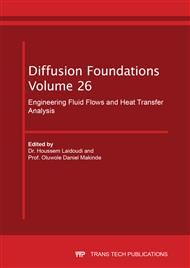[1]
H. Sun, Y. Zhang, B. D. Baleanu, W. Chen,Y. Chen, A new collection of real world applications of fractional calculus in science and engineering, J. commun Nonl. Sci. Numer. Simula. 64(2018)213 -231.
DOI: 10.1016/j.cnsns.2018.04.019
Google Scholar
[2]
N Sene, Stokes' first problem for heated flat plate with Atangana-Baleanu fractional derivative, J. Chaos, Solit. &Fract. Nonl. Sci. and noneq. and compl. Phe.117(2018)68 – 75.
DOI: 10.1016/j.chaos.2018.10.014
Google Scholar
[3]
C. Ionescu, A. Lopes, D. Copot, J. A. T. Machado, J. H. T. Bates, The role of fractional calculus in modeling biological phenomena: A review, Commun. Nonli. Sci. and Numer. Simul. 51(2017)141 – 159.
DOI: 10.1016/j.cnsns.2017.04.001
Google Scholar
[4]
N.A. Shah, V. Dumitru, F. Constantin, Effect of fractional order and magnetic field on the blood flow in cylindrical domains, J. Magt. and Magn. Mat. 409(2016)10 - 19.
Google Scholar
[5]
F. Ali, N. A. Sheikh, I. Khan, M. Saqib, Magnetic field effect on blood flow of casson fluid in axisymmetric cylindrical tube: A fractional model, J. Magt. Magn. Mat. 423(2017)327 -336.
DOI: 10.1016/j.jmmm.2016.09.125
Google Scholar
[6]
R. Ganguly, A. Gaind, S. Sen, I. Puri, Analyzing ferrofluid transport for magnetic drug targeting, J. Magt. and Magn. Mat. 289 (2005)331-334.
DOI: 10.1016/j.jmmm.2004.11.094
Google Scholar
[7]
M. Banerjee, A. Datta, R. Ganguly, Magnetic drug targeting in partly occluded blood vessels using magnetic microspheres. J. Nanotech. Eng. Med.1(4) (2010)1 -9.
DOI: 10.1115/1.4002418
Google Scholar
[8]
S. Shaw, P. Murthy, Magnetic drug targeting in the permeable Blood Vessel---The Effect of Blood Rheology, J. Nanotech. Eng. Med.1(2) (2010)1-11.
Google Scholar
[9]
C. B. Tabi, T. G. Motsumi, C. D. K. Bansi, A. Mohamadou, Nonlinear excitations of blood flow in large vessels under thermal radiations and uniform magnetic field, J. Commun. Nonl. Sci. Numer. Simul. 49(2017)1 – 8.
DOI: 10.1016/j.cnsns.2017.01.024
Google Scholar
[10]
A. Ogulu, A. R. Bestman, Deep heat muscle treatment a mathematical model –I, Acta Phys. Hun. 73 (1993)17 - 27.
DOI: 10.1007/bf03054178
Google Scholar
[11]
G. C. Shit, S. Majee, Computational modeling of MHD flow of blood and heat transfer enhancement in a slowly varying arterial segment, Internat. J. Heat and Fluid Flow. 70(2018)237 – 246.
DOI: 10.1016/j.ijheatfluidflow.2018.02.016
Google Scholar
[12]
S. Sharma, U. Singh, V. K. Katiyar, Magnetic field effect on flow parameters of blood along with magnetic particles in a cylindrical tube, J. Magt. Magn. Mat. 377(2015) 395- 401.
DOI: 10.1016/j.jmmm.2014.10.136
Google Scholar
[13]
S. Majee, G. C. Shit, Numerical investigation of MHD flow of blood and heat transfer enhancement in arterial segment, J. Magt. Magn. Mat. 424(2017)137 – 147.
DOI: 10.1016/j.jmmm.2016.10.028
Google Scholar
[14]
V.K. Sud, G. S. Sekhon, Analysis of blood flow through a model of the human arterial system under periodic body acceleration, J. Biomech. 19 (1986) 929 – 941.
DOI: 10.1016/0021-9290(86)90188-0
Google Scholar
[15]
J. C. Mishra, B. K. Kar, Unsteady flow of blood through arteries in vibration environment, Math. Comput. Model 13(4) (1990)7-17.
Google Scholar
[16]
D. S. Shankar, U. Lee, Nonlinear mathematical analysis for blood flow in constricted artery under periodic body acceleration, Commun. Nonl. Sci. Numer. Simul. 16 (11) (2011) 4390 –4402.
DOI: 10.1016/j.cnsns.2011.03.020
Google Scholar
[17]
G. C. Shit, M. Roy, Pulsatile flow and heat transfer of a magneto-micro-polar fluid through a stenosed artery under the influence of body acceleration, J. Mech. Med. Biol. 11(3) (2011) 643-661.
DOI: 10.1142/s0219519411003909
Google Scholar
[18]
S. U. Siddiqui, S. R. Shah Geeta, A biomechanical approach to study the effect of body acceleration and slip velocity through stenotic artery. J. Appl. Math. Comp. 261(2015) 148 – 155.
DOI: 10.1016/j.amc.2015.03.082
Google Scholar
[19]
S. Singh, R. R. Shah, A numerical model for the effect of stenosis shape on blood flow through an artery using power-law fluid. Adv. Appl. Sci. Res 1(1) (2010)66 – 73.
Google Scholar
[20]
S. R. Shah, An innovative solution for the problem of blood flow through stenosed artery using generalized Bingham plastic fluid model, IMPACT: IJRANSS 1(3) (2013)3551 – 3557.
Google Scholar
[21]
C. D. K. Bansi, C. B. Tabi, T. G. Motsumi, A. Mohamadou, Fractional blood flow in oscillatory arteries with thermal radiation and magnetic field effects, J. Magt. Magn. Mat. 456(2018)38-45.
DOI: 10.1016/j.jmmm.2018.01.079
Google Scholar
[22]
D. Baleanu, O. Agrawal, Hamilton formalism within Caputo's derivative. C. J. Phys.56, (10-11) (2000)1087- 1092.
DOI: 10.1007/s10582-006-0406-x
Google Scholar
[23]
Z. Odibat, Approximations of fractional integrals and Caputo fractional derivatives. Appl. Math. Comput. 178(2) (2006)527 – 533.
DOI: 10.1016/j.amc.2005.11.072
Google Scholar
[24]
H. Stehfests, Algorithm 368: Numerical inversion of Laplace transform [D5],, Cmmun ACM, 13(1970) 47 – 49.
DOI: 10.1145/361953.361969
Google Scholar
[25]
H. Stehfest, Remark on algorithm368: Numerical inversion of Laplace transforms,, Commun. ACM, 13 (1970)624-625.
DOI: 10.1145/355598.362787
Google Scholar
[26]
T. Chinyoka, O. D. Makinde, Computational dynamics of arterial blood flow in the presence of magnetic field and thermal radiation therapy, Adv. Math. Phy. 2014, ID 915640, http: //dx.doi.org/10.1155/2014/915640.
DOI: 10.1155/2014/915640
Google Scholar


